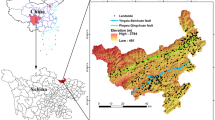Abstract
The experiments aimed to compare the performance of random subspace and random forest models with bagging ensembles and single models in respect of its predictive accuracy were conducted using two popular algorithms M5 tree and multilayer perceptron. All tests were carried out in the WEKA data mining system within the framework of 10-fold cross-validation and repeated holdout splits. A comprehensive real-world cadastral dataset including over 5200 samples and recorded during 11 years served as basis for benchmarking the methods. The overall results of our investigation were as follows. The random forest turned out to be superior to other tested methods, the bagging approach outperformed the random subspace method, single models provided worse prediction accuracy than any other ensemble technique.
Access this chapter
Tax calculation will be finalised at checkout
Purchases are for personal use only
Preview
Unable to display preview. Download preview PDF.
Similar content being viewed by others
References
Amit, Y., Geman, D., Wilder, K.: Joint Induction of Shape Features and Tree Classifiers. IEEE Trans. Pattern Analysis and Machine Intelligence 19(11), 1300–1305 (1997)
Breiman, L.: Bagging Predictors. Machine Learning 24(2), 123–140 (1996)
Breiman, L.: Random Forests. Machine Learning 45(1), 5–32 (2001)
Bryll, R.: Attribute bagging: improving accuracy of classifier ensembles by using random feature subsets. Pattern Recognition 20(6), 1291–1302 (2003)
Bühlmann, P., Yu, B.: Analyzing bagging. Annals of Statistics 30, 927–961 (2002)
Demšar, J.: Statistical comparisons of classifiers over multiple data sets. Journal of Machine Learning Research 7, 1–30 (2006)
Friedman, J.H., Hall, P.: On bagging and nonlinear estimation. Journal of Statistical Planning and Inference 137(3), 669–683 (2007)
Fumera, G., Roli, F., Serrau, A.: A theoretical analysis of bagging as a linear combination of classifiers. IEEE Transactions on Pattern Analysis and Machine Intelligence 30(7), 1293–1299 (2008)
García, S., Herrera, F.: An Extension on “Statistical Comparisons of Classifiers over Multiple Data Sets” for all Pairwise Comparisons. Journal of Machine Learning Research 9, 2677–2694 (2008)
Gashler, M., Giraud-Carrier, C., Martinez, T.: Decision Tree Ensemble: Small Heterogeneous Is Better Than Large Homogeneous. In: 2008 Seventh International Conference on Machine Learning and Applications, ICMLA 2008, pp. 900–905 (2008)
Graczyk, M., Lasota, T., Trawiński, B.: Comparative Analysis of Premises Valuation Models Using KEEL, RapidMiner, and WEKA. In: Nguyen, N.T., Kowalczyk, R., Chen, S.-M. (eds.) ICCCI 2009. LNCS, vol. 5796, pp. 800–812. Springer, Heidelberg (2009)
Ho, T.K.: Random Decision Forest. In: 3rd International Conference on Document Analysis and Recognition, pp. 278–282 (1995)
Ho, T.K.: The Random Subspace Method for Constructing Decision Forests. IEEE Transactions on Pattern Analysis and Machine Intelligence 20(8), 832–844 (1998)
Kempa, O., Lasota, T., Telec, Z., Trawiński, B.: Investigation of bagging ensembles of genetic neural networks and fuzzy systems for real estate appraisal. In: Nguyen, N.T., Kim, C.-G., Janiak, A. (eds.) ACIIDS 2011, Part II. LNCS (LNAI), vol. 6592, pp. 323–332. Springer, Heidelberg (2011)
Kotsiantis, S.: Combining bagging, boosting, rotation forest and random subspace methods. Artificial Intelligence Review 35(3), 223–240 (2010)
Król, D., Lasota, T., Trawiński, B., Trawiński, K.: Investigation of Evolutionary Optimization Methods of TSK Fuzzy Model for Real Estate Appraisal. International Journal of Hybrid Intelligent Systems 5(3), 111–128 (2008)
Krzystanek, M., Lasota, T., Telec, Z., Trawiński, B.: Analysis of Bagging Ensembles of Fuzzy Models for Premises Valuation. In: Nguyen, N.T., Le, M.T., Świątek, J. (eds.) Intelligent Information and Database Systems. LNCS, vol. 5991, pp. 330–339. Springer, Heidelberg (2010)
Lasota, T., Mazurkiewicz, J., Trawiński, B., Trawiński, K.: Comparison of Data Driven Models for the Validation of Residential Premises using KEEL. International Journal of Hybrid Intelligent Systems 7(1), 3–16 (2010)
Lasota, T., Telec, Z., Trawiński, B., Trawiński, K.: Exploration of Bagging Ensembles Comprising Genetic Fuzzy Models to Assist with Real Estate Appraisals. In: Corchado, E., Yin, H. (eds.) IDEAL 2009. LNCS, vol. 5788, pp. 554–561. Springer, Heidelberg (2009)
Lasota, T., Telec, Z., Trawiński, B., Trawiński, K.: Investigation of the eTS Evolving Fuzzy Systems Applied to Real Estate Appraisal. Journal of Multiple-Valued Logic and Soft Computing 17(2-3), 229–253 (2011)
Lughofer, E., Trawiński, B., Trawiński, K., Lasota, T.: On-Line Valuation of Residential Premises with Evolving Fuzzy Models. In: Corchado, E., Kurzyński, M., Woźniak, M. (eds.) HAIS 2011, Part I. LNCS (LNAI), vol. 6678, pp. 107–115. Springer, Heidelberg (2011)
Polikar, R.: Ensemble Learning. Scholarpedia 4(1), 2776 (2009)
Rodríguez, J.J., Kuncheva, L.I., Alonso, C.J.: Rotation Forest: A New Classifier Ensemble Method. IEEE Transactions on Pattern Analysis and Machine Intelligence 28(10), 1619–1630 (2006)
Witten, I.H., Frank, E.: Data Mining: Practical machine learning tools and techniques, 2nd edn. Morgan Kaufmann, San Francisco (2005)
Author information
Authors and Affiliations
Editor information
Editors and Affiliations
Rights and permissions
Copyright information
© 2011 Springer-Verlag Berlin Heidelberg
About this paper
Cite this paper
Lasota, T., Łuczak, T., Trawiński, B. (2011). Investigation of Random Subspace and Random Forest Methods Applied to Property Valuation Data. In: Jędrzejowicz, P., Nguyen, N.T., Hoang, K. (eds) Computational Collective Intelligence. Technologies and Applications. ICCCI 2011. Lecture Notes in Computer Science(), vol 6922. Springer, Berlin, Heidelberg. https://doi.org/10.1007/978-3-642-23935-9_14
Download citation
DOI: https://doi.org/10.1007/978-3-642-23935-9_14
Publisher Name: Springer, Berlin, Heidelberg
Print ISBN: 978-3-642-23934-2
Online ISBN: 978-3-642-23935-9
eBook Packages: Computer ScienceComputer Science (R0)




